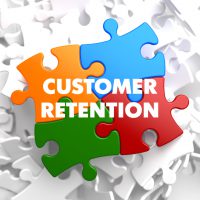Customer Retention Ranks Higher than Acquisition for 2014

Nearly 28 million small businesses in America provide 55% of all jobs and account for more than half (54%) of all U.S. sales – and customers play a critical role.
Customer growth reigns high on the list of most business objectives, but a recent report from BIA/Kelsey and Manta, which surveyed 1,000 small business owners (SBOs), reveals a dramatic shift from acquisition to retention. In fact, most small businesses (62%) plan to spend the majority of their 2014 annual marketing budgets on retaining existing customers rather than trying to acquire new ones. In 2012 most small businesses were spending more than half of their marketing budget on finding new customers.
For most businesses, it costs more to acquire a new customer than it does to increase the lifetime value of existing customers. So while new business development is important, the research tells us it is more expensive and less lucrative than to nurture repeat business. In fact, it can be up to ten times more costly to acquire a new customer, and a repeat customer spends 67% more than a new one. Therefore, strategies to connect with customers and drive retention and repeat sales need to be in place.
Some of the best strategies are email, Facebook and loyalty programs because they are best suited for engaging existing customers. While 52.1% of SBOs use a Facebook page for advertising and promotion and 39.4% use email marketing, only 34% of SBOs have a loyalty program. Moreover, the majority of SBO loyalty programs are offline rather than online, failing to take advantage of the technologies that enable seamless implementation and deeper customer insight. Research by BIA/Kelsey found that only 29% of SBOs use a Customer Relationship Management (CRM) tool to keep track of customer information. There is a divide between valuing existing customers and the programs used to effectively drive retention. Fortunately technology provides access to programs that can be used to effectively drive retention, but the constant influx of new technology can be overwhelming.
In addition to the lower cost, existing customers can help cross-sell, and because there is already a relationship, there is a level of trust encouraging recommendations to friends and family via word-of-mouth.
Loyalty programs provide two key functions: they give customers rewards for brand loyalty and they provide the issuing company with a wealth of consumer information. While companies can evaluate anonymous purchases, the use of a loyalty program gives additional information about the type of products that may be purchased together, and whether certain coupons are more effective than others. Manta recommends ten tips to jump start a customer loyalty program. To learn more about each one and how they might work for your company check out this report.
1. Start with the End in Mind
2. Determine the Audience
3. Structure the Program ROI-Positive
4. Encourage Customers to Opt-In
5. Automate, Automate, Automate
6. Email
7. Go Social
8. Get Integrated
9. Go Mobile
10. Keep Them Engaged with Consistent Communication
We think these tips are a great place to start in building your loyalty programs and helping your business of any size increase customer retention.
Bullets
- In 2013, 49% of retailers said that they couldn’t keep up with the new ways consumers are using technology, 44% or retailers used digital channels to drive traffic in stores versus 28% in 2012, and 25% of retailers said that they will switch their company from primarily traditional marketing tactics to primarily digital marketing tactics. (RSR Research)
- Today, customers are doing more research online and have a pretty good idea of what they want to purchase before directly interacting with a brand rep with as much as 60% of the purchase decision being made before someone talks to a sales rep. (Marketing News)
- Nearly half of U.S. consumers are “always on”, using three different devices every day, going online multiple times each day and accessing the internet from at least three different locations. (“The Always-On Consumer”, Vivaldi Partners and Respondi, February, 2014)
- According to the Pew Internet and American Life Project, 63% of adult cell phone owners use their phones to go online. Of those users, 34% use their phones as their main method for accessing the internet. (Marketing Insights)
- 50% of people say that even if they like a business, they will use them less often if the website isn’t mobile-friendly, and that 67% of mobile users say that when they visit a mobile-friendly site, they’re more likely to buy a site’s product or service. (Marketing Insights)
